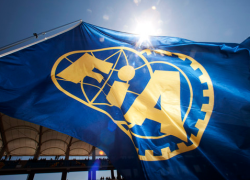
On Saturday at the Abu Dhabi Grand Prix, the FIA received a request from Mercedes regarding clarification on wind tunnel regulations and the limits on wind tunnel work.
The FIA have ruled on the matter and have told teams that teams are not allowed to collude on aerodynamic testing, more specifically, customer teams with technical partnerships with manufacturer teams.
This comes after Mercedes pointed out a few ambiguities in the rules and after corresponding with the FIA on the matter, were referred to the race stewards. The stewards on Sunday made a recommendation to the FIA in an 8-page document.
The controversy started when concerns were raised that Ferrari had benefited from additional wind tunnel testing which was performed with the Haas F1 team, who will be using various Ferrari components in their cars when they make their debut in F1 next year. Haas F1 were not bound by the current regulations which limits wind tunnel testing. Until Sunday’s ruling by the FIA.
Ferrari and Haas were cleared by the FIA after examining the logs provided to them by Haas F1 and Ferrari. “Having examined the reports (including audit reports team facilities) provided to us, the Stewards confirm that there is no evidence that competitors have not complied with the requirements of Appendices 6 and 8 as they were interpreted prior to today’s date,” said the FIA in their settlement document.
In the settlement document the FIA state:”The Stewards recommend to the FIA that in future once a potential competitor (as opposed to Official Entry) applies to be a competitor in the FIA Formula One World Championship and this application is accepted, that competitor should be bound by Appendices 6 and 8 (and for that matter any other appropriate sections of the Formula One Sporting and Technical Regulations).”
It was also noted by the FIA that the ruling will apply going forward and not retrospectively.
The FIA also issued a list of activities that will be deemed attempts to circumvent the regulations with regards to wind tunnel testing.
- No employee or consultant of a competitor who is involved in aerodynamic development may pass any information obtained under their own ATR quota to an employee or consultant of another competitor.
- No employee of a competitor who is involved in aerodynamic development, who leaves that company and takes up a similar position with another competitor, may do so without a suitable (or normal) period of “gardening leave” or “isolation”.
- No employee of a competitor who is involved in aerodynamic development, and who leaves that company and takes up a similar position with another competitor, may then return to the original competitor without a suitable (or normal) period of “gardening leave” or “isolation”.
- No employee of a competitor who is involved in aerodynamic development, and who then leaves that company, may pass information obtained under their former employer’s ATR quota to an employee or consultant of another competitor before a suitable (or normal) period of “gardening leave” or “isolation” has elapsed.
- No employee of an external entity who is involved in F1 aerodynamic development may be employed by a competitor, on a permanent or temporary basis, without a suitable (or normal) period of “gardening leave” or “isolation”.
- No employee of a competitor who is involved in aerodynamic development may be seconded to, or temporarily employed by, another competitor unless such secondment or employment is a genuine long term arrangement for the sole purpose of providing the other competitor with technical expertise. Any seconded employee must not then return to the original competitor without a suitable (or normal) period of “gardening leave” or “isolation”. Three months would be considered as a genuine long term arrangement.
- No competitor may acquire aerodynamic surfaces from an external entity (even if such entity claims to have designed them for its own purposes), unless any aerodynamic testing resource used to develop the surfaces is counted within the relevant competitor’s ATR quota.
- Teams sharing a wind tunnel (or any other aerodynamic testing resource as referred to in Appendix 8, including a CFD cluster) must put appropriate procedures in place to avoid any breach of confidentiality or of the general restrictions of Appendix 6 and Appendix 8. This would include (but not be limited to):
(i) ensuring staff shared by both parties or employed by one party but involved in the operational part of the aerodynamic testing of the other party (such as operating or maintaining the wind tunnel and/or CFD hardware) give contractual covenants not to pass information or to allow information to pass between the parties.
(ii) putting the physical infrastructure in place so the two parties operate their support activities (such as wind tunnel model preparation), other than the operational part of the testing mentioned above, in separate environments.
(iii) putting the IT infrastructure in place so the two parties operate on separate networks and store their data on separate (at least virtually) storage hardware.


